Understanding What you're teaching your kids
Because they’re learning from what you do, not what you say.
The Lessons We Don’t Mean to Teach
Every day, our kids watch us make decisions — about money, time, and priorities. Whether we realize it or not, they’re learning what “normal” looks like. When they hear, “We can’t afford that,” they don’t just hear limits. They hear fear.
When they see us swipe a card without thinking, they don’t just see convenience. They see control. And when they hear, “I’ll be happy when this is paid off,” they learn that peace comes later — not now.
I still remember being a kid, standing next to my mom at the grocery store.
She handed me the calculator and told me to punch in every price as she added items to the cart. At the time, I thought it was fun — my way of helping.
Now I realize she wasn’t just teaching me math — she was teaching me money stress. I learned that every purchase had to be justified, that every dollar needed to be counted. The only decision I ever got to make was which cereal I’d pick for the week.
And even that came with a limit. She was being responsible — but what she was really teaching me was how to live inside constraint.
I remember it being a big deal if we even went to McDonald’s. It was forty-five minutes away, but it felt like a road trip. And whenever we asked for it, my mom would say, “We got McDonald’s at home.”
She’d make a hamburger that looked nothing like McDonald’s — but to her, it was close enough. Those moments stuck with me.
They taught me that fast food was a luxury. If you could go out to eat, you were rich. If you could afford it, you were “doing well.”
What We Pass Down — Intentionally or Not
Most of us want our kids to grow up with less stress than we had.
But too often, we pass down the same financial patterns — just with different numbers. I remember my parents pushing car payments to the limit, which really meant we probably shouldn’t have gotten that car at all.
Over the years, I think they’ve owned close to fifty brand-new vehicles.
Even today, they spend around $2,000 every month between car payments, insurance, and gas — and then tell me, “We don’t have any money. We’re poor.” The ironic part? They hardly drive anymore.
It takes them almost a year to put 3,000 miles on their cars.
There’s no reason they need two vehicles, yet they keep them both — because that’s what they’ve always done.
They weren’t being careless — they were doing what they were taught to do:
follow the rules, make the payment, and believe that was success.
But what they were really teaching was dependence — on a system designed to keep you paying forever.
And one of the things that taught me, as a kid, was this:
- If you could go out to eat, you were rich.
- If you could afford a meal out, you were “doing well.”
- So I picked up that same habit.
As I got older, I realized how those little lessons — taught without words — turned into big financial decisions.
Over time, I had to unlearn them, to rebuild my habits around purpose instead of emotion. But it isn’t easy, because the world constantly tries to reinforce those bad habits.
It rewards convenience. It normalizes excess. It praises consumption.
And that’s exactly what our kids are learning too.
“We’re not just fighting debt — we’re fighting decades of conditioning.”
The Uncomfortable Mirror
If your child learned everything, they know about money by watching you this year —
Would they learn patience or pressure?
Would they see planning or panic?
We tell them to save, but they watch us spend.
We tell them to give, but they hear us say there’s not enough.
We tell them to chase happiness, but they see us chasing “just a little more.”
And when we tell them that “this is just how life works,” We unintentionally teach them to settle for stress.
“They don’t need a bigger allowance — they need a better example.”
Breaking the Cycle
You can’t control what you weren’t taught — but you can decide what comes next. When your kids see you living with structure instead of struggle,
they start to believe something different about money: That it’s not something to chase or fear — it’s something to guide.
Teaching them starts with showing them:
- How to wait — not just want.
- How to give — not just get.
- How to structure — not just spend.
You don’t need to lecture them about money.
You just need to live differently around it.
A Tacoma Example
One Tacoma mom I worked with said, “My kids thought money just disappeared every month.”
She wasn’t bad with money — she was just busy. She worked full time, paid bills on autopilot, and told herself she’d figure it out later.
When we restructured her plan, she didn’t just find financial peace — she found teachable moments.
She started including her kids when she checked her progress. Now, instead of saying, “We can’t afford that,” she says, “That’s not what we’re choosing right now.” And her kids are learning something powerful: that money follows direction, not emotion.
Faith, Stewardship, and Structure
This isn’t about perfection — it’s about stewardship.
Many parents want to give more, teach more, and live with more generosity.
But it’s hard to model peace when you feel pressure every payday.
Stewardship means using what you have with purpose — and teaching your kids that freedom doesn’t come from more stuff, but from knowing what matters most.
“Faith without structure leads to frustration. Stewardship gives both.”
The Financial Minimalist Perspective
At Financial Minimalist, we teach families how to model control, clarity, and calm — because your kids are learning your rhythm.
You don’t have to wait until you’re debt-free to start teaching them.
You just have to show them what progress looks like.
When your money moves with purpose, your family learns peace — one paycheck at a time.
“You can’t teach freedom if you’re still renting your time.”
Frequently Asked Questions
When should I start teaching my kids about money?
Now. Kids as young as five understand giving, saving, and waiting — it’s never too early to model structure.
What if I’ve made mistakes with money?
Perfect. That makes you relatable. Teach them how you’re changing your approach — that’s more valuable than pretending you’ve always had it right.
How do I include my kids without overwhelming them?
Show, don’t tell. Involve them in small wins — like tracking progress or choosing a family goal. Keep it positive.
Does this mean I have to talk about debt with my kids?
Only when they’re ready. Focus less on the debt and more on the structure — the “why” behind your decisions.
Can the Financial Minimalist Plan work for families with kids?
Absolutely. In fact, that’s where it shines. It simplifies the path, helps you control flow, and turns everyday choices into teaching moments.
Key Takeaways
- Kids learn more from what we do than what we say.
- Money habits are caught, not taught — start modeling structure.
- Replace “we can’t afford that” with “that’s not what we’re choosing.”
- Teach them patience, generosity, and purpose through your actions.
- Your structure today becomes their confidence tomorrow.
Final Thought
You don’t have to give your kids everything — just the foundation to create anything. When you stop chasing and start structuring, you teach them what real freedom looks like.
“The most valuable thing you’ll ever hand down isn’t money — it’s mindset.”









